Submarine fault scarps in the Sea of Marmara pull-apart ... - HAL - IRD
Submarine fault scarps in the Sea of Marmara pull-apart ... - HAL - IRD
Submarine fault scarps in the Sea of Marmara pull-apart ... - HAL - IRD
You also want an ePaper? Increase the reach of your titles
YUMPU automatically turns print PDFs into web optimized ePapers that Google loves.
Geochemistry<br />
Geophysics<br />
Geosystems G 3<br />
G 3 armijo et al.: sea <strong>of</strong> marmara <strong>pull</strong>-<strong>apart</strong> 10.1029/2004GC000896<br />
The two images reveal <strong>the</strong> f<strong>in</strong>e details <strong>of</strong> <strong>the</strong><br />
cumulative scarp <strong>in</strong>clud<strong>in</strong>g secondary branches,<br />
echelons, horse-tail term<strong>in</strong>ations, etc., comparable<br />
to active trans-tensional <strong>fault</strong> <strong>scarps</strong> commonly<br />
observed on land, under prevail<strong>in</strong>g erosional conditions.<br />
Slope-degrad<strong>in</strong>g processes such as gravity<br />
collapse, slid<strong>in</strong>g, talus creep and overall sediment<br />
transport appear to prevail over sediment deposition<br />
across <strong>the</strong> whole 50-m-high cumulative scarp<br />
(over a width <strong>of</strong> about 100 m; Figure 4c). Such<br />
conditions can be readily appreciated <strong>in</strong> <strong>the</strong> seabottom<br />
pictures (Figure 5).<br />
[21] The most strik<strong>in</strong>g feature def<strong>in</strong>ed <strong>in</strong> both <strong>the</strong><br />
side-scan sonar and <strong>the</strong> microbathymetry is <strong>the</strong><br />
occurrence <strong>of</strong> small-scale, sharp, steep <strong>scarps</strong> that<br />
lacerate <strong>the</strong> larger cumulative scarp (Figures 4a,<br />
4b, and 5). The small-scale <strong>scarps</strong> (called hereafter<br />
<strong>in</strong>dividual <strong>scarps</strong>) cut obliquely across <strong>the</strong> slopes<br />
<strong>of</strong> <strong>the</strong> cumulative <strong>scarps</strong>, with a f<strong>in</strong>er en echelon<br />
branch<strong>in</strong>g structure. The steepness and <strong>the</strong> sharpness<br />
<strong>of</strong> <strong>the</strong> <strong>in</strong>dividual <strong>scarps</strong> suggest that <strong>the</strong>y<br />
correspond to <strong>the</strong> latest scarp-form<strong>in</strong>g <strong>in</strong>crements.<br />
Those steep <strong>in</strong>crements are also seen directly <strong>in</strong> <strong>the</strong><br />
imagery taken at <strong>the</strong> sea bottom (see Figure 5b).<br />
The <strong>in</strong>dividual <strong>scarps</strong> seen <strong>in</strong> <strong>the</strong> Central Bas<strong>in</strong><br />
appear comparable to recent earthquake <strong>scarps</strong><br />
observed elsewhere on land. Some strik<strong>in</strong>g similarities<br />
can be appreciated <strong>in</strong> Figure 6.<br />
[22] Never<strong>the</strong>less it is difficult to discern strictly<br />
<strong>the</strong> amount <strong>of</strong> slip associated with <strong>the</strong> last scarpform<strong>in</strong>g<br />
event only. An ‘‘<strong>in</strong>dividual’’ scarp could<br />
result from more than one event. Closer exam<strong>in</strong>ation<br />
<strong>of</strong> microbathymetry pr<strong>of</strong>iles across <strong>in</strong>dividual<br />
<strong>scarps</strong> and <strong>of</strong> <strong>the</strong> direct bottom imagery allows us<br />
to estimate, with<strong>in</strong> error, <strong>the</strong> slip attributable to <strong>the</strong><br />
last scarp-form<strong>in</strong>g event. Three <strong>in</strong>dividual en echelon<br />
<strong>scarps</strong> (marked with arrows labeled s1, s2 and<br />
s3 <strong>in</strong> <strong>the</strong> side-scan sonar image, Figure 4b) can be<br />
appreciated as slope breaks over three secondary<br />
<strong>fault</strong>s <strong>in</strong> <strong>the</strong> microbathymetry pr<strong>of</strong>ile and <strong>the</strong><br />
<strong>in</strong>terpreted section (Figure 4c). The enlargement<br />
<strong>of</strong> <strong>the</strong> microbathymetry data shows that scarp s2 is<br />
about 1–2 m high (Figure 4d) with a free face that<br />
occupies a large part <strong>of</strong> it. This feature is seen <strong>in</strong><br />
<strong>the</strong> photo imagery <strong>of</strong> this scarp (s2) and o<strong>the</strong>r<br />
correlatable <strong>scarps</strong> (Figures 5b, 5c, and 5d). Thus<br />
<strong>the</strong> last scarp-form<strong>in</strong>g event at s2 appears to have<br />
contributed an <strong>in</strong>cremental throw <strong>of</strong> 1–2 m. Similarly,<br />
s3 would have contributed a throw <strong>of</strong> 0.5–<br />
1 m dur<strong>in</strong>g <strong>the</strong> last scarp-form<strong>in</strong>g event.<br />
[23] Free faces are easier to discern and <strong>in</strong>cremental<br />
throws easier to determ<strong>in</strong>e for <strong>the</strong> two upper<br />
<strong>in</strong>dividual <strong>scarps</strong> (s2 and s3), where <strong>the</strong> slope <strong>of</strong><br />
<strong>the</strong> cumulative scarp is shallower, than for scarp s1<br />
that is located at <strong>the</strong> very base <strong>of</strong> <strong>the</strong> cumulative<br />
scarp, where its slope is steeper. For basal scarp<br />
s1, which is generally <strong>the</strong> largest <strong>of</strong> <strong>in</strong>dividual<br />
<strong>scarps</strong> <strong>in</strong> any section across <strong>the</strong> SW boundary<br />
<strong>fault</strong>, <strong>the</strong> <strong>in</strong>cremental throw correspond<strong>in</strong>g to <strong>the</strong><br />
last scarp-form<strong>in</strong>g event could be similar (or<br />
larger) to that determ<strong>in</strong>ed for scarp s2, but this<br />
assessment rema<strong>in</strong>s very uncerta<strong>in</strong>. Indeed it is<br />
difficult to estimate with accuracy <strong>the</strong> total <strong>in</strong>cremental<br />
throw correspond<strong>in</strong>g to <strong>the</strong> last scarpform<strong>in</strong>g<br />
event, by summ<strong>in</strong>g <strong>the</strong> contributions<br />
<strong>of</strong> s1, s2 and s3 along <strong>the</strong> section presented <strong>in</strong><br />
Figure 4c. With caution we estimate for <strong>the</strong> last<br />
event a total <strong>in</strong>cremental throw <strong>of</strong> at least 2 m and<br />
possibly not much more than 4 m.<br />
[24] Individual <strong>scarps</strong> with <strong>the</strong> same morphologic<br />
characteristics and bear<strong>in</strong>g free faces <strong>of</strong> similar size<br />
were followed visually with <strong>the</strong> ROV (video cameras)<br />
for many hundred meters along strike, <strong>in</strong> this<br />
segment and <strong>the</strong> o<strong>the</strong>r segments <strong>of</strong> <strong>the</strong> SW boundary<br />
<strong>fault</strong>. The microbathymetry survey and <strong>the</strong><br />
side-scan data suggest this set <strong>of</strong> <strong>in</strong>cremental<br />
<strong>scarps</strong> with significant normal slip is cont<strong>in</strong>uous<br />
all along <strong>the</strong> whole SW boundary <strong>fault</strong> <strong>of</strong> <strong>the</strong><br />
<strong>in</strong>ner <strong>pull</strong>-<strong>apart</strong>, for a total length <strong>of</strong> about 8 km<br />
(Figure 2). We deduce that <strong>the</strong> SW boundary <strong>fault</strong><br />
has ruptured entirely dur<strong>in</strong>g this event possibly<br />
with an average throw <strong>of</strong> no less than 2–4 m. No<br />
Figure 4. Morphology <strong>of</strong> a <strong>fault</strong> segment <strong>in</strong> <strong>the</strong> Central Bas<strong>in</strong>. The 1.5-km-long segment shown has significant<br />
normal component <strong>of</strong> slip. It is one <strong>of</strong> <strong>the</strong> north-dipp<strong>in</strong>g segments form<strong>in</strong>g <strong>the</strong> left-stepp<strong>in</strong>g en echelon <strong>fault</strong> system at<br />
<strong>the</strong> SW edge <strong>of</strong> <strong>the</strong> <strong>in</strong>ner <strong>pull</strong>-<strong>apart</strong> (Figures 2 and 3). (a) Bathymetry. The map comb<strong>in</strong>es background EM300 data<br />
(30 m resolution, 1 m vertical accuracy) with microbathymetry (white outl<strong>in</strong>e) collected near bottom with <strong>Sea</strong>bat<br />
8101 mounted on ROV Victor 6000 (0.5 m resolution, 0.1 m vertical accuracy). Contours every 1 m. Black and<br />
smaller red crosses <strong>in</strong>dicate pr<strong>of</strong>ile location. (b) Side-scan sonar image. Pr<strong>of</strong>ile location is <strong>in</strong>dicated for comparison.<br />
Arrowed s1, s2, and s3 identify <strong>in</strong>dividual <strong>scarps</strong>. (c) Section constructed with comb<strong>in</strong>ed bathymetry and stratigraphy<br />
(3.5 kHz and core data; colors as <strong>in</strong> Figure 3). The ROV microbathymetry data (small red crosses) resolves details <strong>of</strong><br />
<strong>the</strong> scarp morphology (not resolved with <strong>the</strong> background bathymetry; black crosses). The 50-m-high cumulative<br />
scarp is formed <strong>of</strong> 3 steps, which are marked by <strong>in</strong>dividual <strong>scarps</strong> (s1, s2, and s3; identified <strong>in</strong> <strong>the</strong> side-scan sonar<br />
image). Stratigraphy is not resolved <strong>in</strong> <strong>fault</strong> blocks between s1 and s2. (d) Enlargement <strong>of</strong> <strong>in</strong>dividual scarp s2. The<br />
1- to 2-m-high free face corresponds to <strong>the</strong> last <strong>fault</strong> rupture. Stratigraphy is schematic. No vertical exaggeration.<br />
12 <strong>of</strong> 29




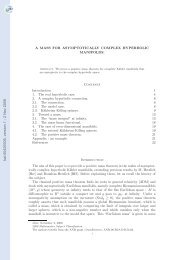

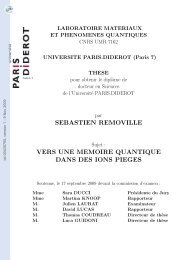
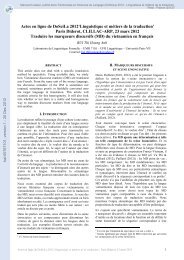
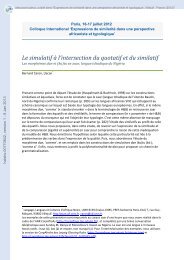
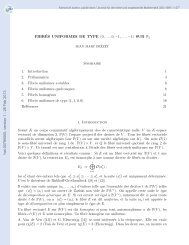
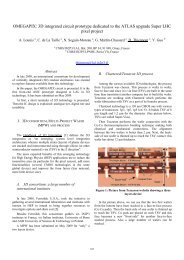
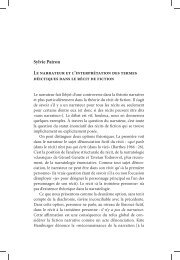
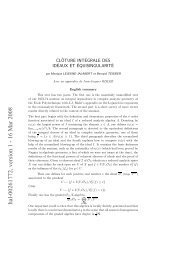
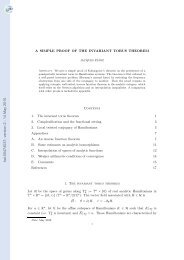

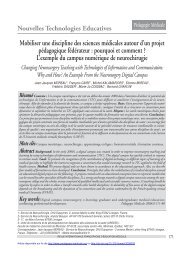

![[tel-00433556, v1] Relation entre Stress Oxydant et Homéostasie ...](https://img.yumpu.com/19233319/1/184x260/tel-00433556-v1-relation-entre-stress-oxydant-et-homeostasie-.jpg?quality=85)